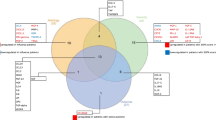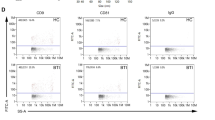Abstract
Bacterial translocation in patients with cirrhosis induces a marked proinflammatory activity that may be different against viable bacteria or bacterial products. The aim of this study is to identify new markers of bacterial translocation by investigating bacterial-driven peptides and correlate their presence with the inflammatory response. Patients with cirrhosis and ascites were included. An analysis by two-dimensional polyacrylamide gel electrophoresis of ascitic fluid total protein from patients (n = 47) and from frequently detected bacterial strains was performed. Two-dimensional maps were digitally compared. The identification of possible markers was performed by mass spectrometry. TNF-α, IFN-γ, IL-12, nitric oxide, and proteins of the complement and lipopolysaccharide-binding protein levels were measured in ascitic fluid samples of patients by enzyme-linked immunosorbent assay. Patients were distributed according to the presence (group I, n = 16) and absence (group II, n = 31) of serum and ascitic fluid bacterial DNA. Among clinical and analytical differences between groups, only mean arterial pressure was significantly higher in patients from group II. Identified bacterial peptides were associated with bacterial protection against immune defenses and included glyceraldehyde-3-phosphate dehydrogenase A, Porin OmpC, and HSP60. Eight patients from group I also showed bacterial peptides, whereas none from group II did. All studied mediators of immune activation were significantly higher in patients with bacterial DNA than in patients without bacterial DNA. TNF-α, IFN-γ, and proteins of the complement were significantly increased in patients with bacterial peptides versus those without bacterial peptides. Bacterial peptide translocation is present in the ascitic fluid of a subgroup of patients with advanced cirrhosis and is associated with an increased immune response.


Similar content being viewed by others
References
Such J, Runyon BA (1998) Spontaneous bacterial peritonitis. Clin Infect Dis 27:669–674
Runyon BA, Squier S, Borzio M (1994) Translocation of gut bacteria in rats with cirrhosis to mesenteric lymph nodes partially explains the pathogenesis of spontaneous bacterial peritonitis. J Hepatol 21:792–796
Such J, Guarner C, Enriquez J, Rodriguez JL, Seres I, Vilardell F (1988) Low C3 in cirrhotic ascites predisposes to spontaneous bacterial peritonitis. J Hepatol 6:80–84
Runyon BA (1986) Low-protein-concentration ascitic fluid is predisposed to spontaneous bacterial peritonitis. Gastroenterology 91:1343–1346
Such J, Frances R, Munoz C, Zapater P, Casellas JA, Cifuentes A, Rodriguez-Valera F, Pascual S, Sola-Vera J, Carnicer F, Uceda F, Palazon JM, Perez-Mateo M (2002) Detection and identification of bacterial DNA in patients with cirrhosis and culture-negative, nonneutrocytic ascites. Hepatology 36:135–141
Guarner C, Gonzalez-Navajas JM, Sanchez E, Soriano G, Frances R, Chiva M, Zapater P, Benlloch S, Munoz C, Pascual S, Balanzo J, Perez-Mateo M, Such J (2006) The detection of bacterial DNA in blood of rats with CCl(4)-induced cirrhosis with ascites represents episodes of bacterial translocation. Hepatology 44:633–639
Tandon P, Garcia-Tsao G (2008) Bacterial infections, sepsis, and multiorgan failure in cirrhosis. Semin Liver Dis 28:26–42
Zapater P, Frances R, Gonzalez-Navajas JM, de la Hoz MA, Moreu R, Pascual S, Monfort D, Montoliu S, Vila C, Escudero A, Torras X, Cirera I, Llanos L, Guarner-Argente C, Palazon JM, Carnicer F, Bellot P, Guarner C, Planas R, Sola R, Serra MA, Munoz C, Perez-Mateo M, Such J (2008) Serum and ascitic fluid bacterial DNA: a new independent prognostic factor in noninfected patients with cirrhosis. Hepatology 48:1924–1931
Klinman DM, Conover J, Coban C (1999) Repeated administration of synthetic oligodeoxynucleotides expressing CpG motifs provides long-term protection against bacterial infection. Infect Immun 67:5658–5663
Klinman DM, Yi AK, Beaucage SL, Conover J, Krieg AM (1996) CpG motifs present in bacteria DNA rapidly induce lymphocytes to secrete interleukin 6, interleukin 12, and interferon gamma. Proc Natl Acad Sci U S A 93:2879–2883
Chu RS, Targoni OS, Krieg AM, Lehmann PV, Harding CV (1997) CpG oligodeoxynucleotides act as adjuvants that switch on T helper 1 (Th1) immunity. J Exp Med 186:1623–1631
Frances R, Munoz C, Zapater P, Uceda F, Gascon I, Pascual S, Perez-Mateo M, Such J (2004) Bacterial DNA activates cell mediated immune response and nitric oxide overproduction in peritoneal macrophages from patients with cirrhosis and ascites. Gut 53:860–864
Navasa M, Follo A, Filella X, Jimenez W, Francitorra A, Planas R, Rimola A, Arroyo V, Rodes J (1998) Tumor necrosis factor and interleukin-6 in spontaneous bacterial peritonitis in cirrhosis: relationship with the development of renal impairment and mortality. Hepatology 27:1227–1232
Garcia-Tsao G, Angulo P, Garcia JC, Groszmann RJ, Cadelina GW (1998) The diagnostic and predictive value of ascites nitric oxide levels in patients with spontaneous bacterial peritonitis. Hepatology 28:17–21
Runyon BA (1986) Paracentesis of ascitic fluid: a safe procedure. Arch Intern Med 146:2259–2261
Runyon BA, Umland ET, Merlin T (1987) Inoculation of blood culture bottles with ascitic fluid. Improved detection of spontaneous bacterial peritonitis. Arch Intern Med 147:73–75
Frances R, Gonzalez-Navajas JM, Zapater P, Munoz C, Cano R, Pascual S, Santana F, Marquez D, Perez-Mateo M, Such J (2007) Translocation of bacterial DNA from Gram-positive microorganisms is associated with a species-specific inflammatory response in serum and ascitic fluid of patients with cirrhosis. Clin Exp Immunol 150:230–237
Wennmalm A, Benthin G, Edlund A, Jungersten L, Kieler-Jensen N, Lundin S, Wesfelt UN, Petersson AS, Waagstein F (1993) Metabolism and excretion of nitric oxide in humans. An experimental and clinical study. Circ Res 73:1121–1127
Wiest R, Garcia-Tsao G (2005) Bacterial translocation (BT) in cirrhosis. Hepatology 41:422–433
Albillos A, de La HA, Gonzalez M, Moya JL, Calleja JL, Monserrat J, Ruiz-del-Arbol L, Alvarez-Mon M (2003) Increased lipopolysaccharide binding protein in cirrhotic patients with marked immune and hemodynamic derangement. Hepatology 37:208–217
Krieg AM (2002) CpG motifs in bacterial DNA and their immune effects. Annu Rev Immunol 20:709–760
Sweet MJ, Hume DA (1996) Endotoxin signal transduction in macrophages. J Leukoc Biol 60:8–26
Young RA (1990) Stress proteins and immunology. Annu Rev Immunol 8:401–420
Alberti S, Rodriquez-Quinones F, Schirmer T, Rummel G, Tomas JM, Rosenbusch JP, Benedi VJ (1995) A porin from Klebsiella pneumoniae: sequence homology, three-dimensional model, and complement binding. Infect Immun 63:903–910
Terao Y, Yamaguchi M, Hamada S, Kawabata S (2006) Multifunctional glyceraldehyde-3-phosphate dehydrogenase of Streptococcus pyogenes is essential for evasion from neutrophils. J Biol Chem 281:14215–14223
Frances R, Zapater P, Gonzalez-Navajas JM, Munoz C, Cano R, Moreu R, Pascual S, Bellot P, Perez-Mateo M, Such J (2008) Bacterial DNA in patients with cirrhosis and noninfected ascites mimics the soluble immune response established in patients with spontaneous bacterial peritonitis. Hepatology 47:978–985
Guarner C, Soriano G, Tomas A, Bulbena O, Novella MT, Balanzo J, Vilardell F, Mourelle M, Moncada S (1993) Increased serum nitrite and nitrate levels in patients with cirrhosis: relationship to endotoxemia. Hepatology 18:1139–1143
Fernandez J, Navasa M, Gomez J, Colmenero J, Vila J, Arroyo V, Rodes J (2002) Bacterial infections in cirrhosis: epidemiological changes with invasive procedures and norfloxacin prophylaxis. Hepatology 35:140–148
Funding
This study was funded by grants CP05/005, PI05/1784, and PI06/1453 from Instituto de Salud Carlos III, Madrid, Spain. Rocío Caño is recipient of a grant by Fundación FCVI–HGUA, Alicante, Spain.
Disclosure statement
The authors declare that they have no conflicting interests related to this study.
Author information
Authors and Affiliations
Corresponding authors
Additional information
R. Francés and J. Such contributed equally to the design and development of this investigation.
Rights and permissions
About this article
Cite this article
Caño, R., Llanos, L., Zapater, P. et al. Proteomic evidence of bacterial peptide translocation in afebrile patients with cirrhosis and ascites. J Mol Med 88, 487–495 (2010). https://doi.org/10.1007/s00109-009-0582-9
Received:
Revised:
Accepted:
Published:
Issue Date:
DOI: https://doi.org/10.1007/s00109-009-0582-9




